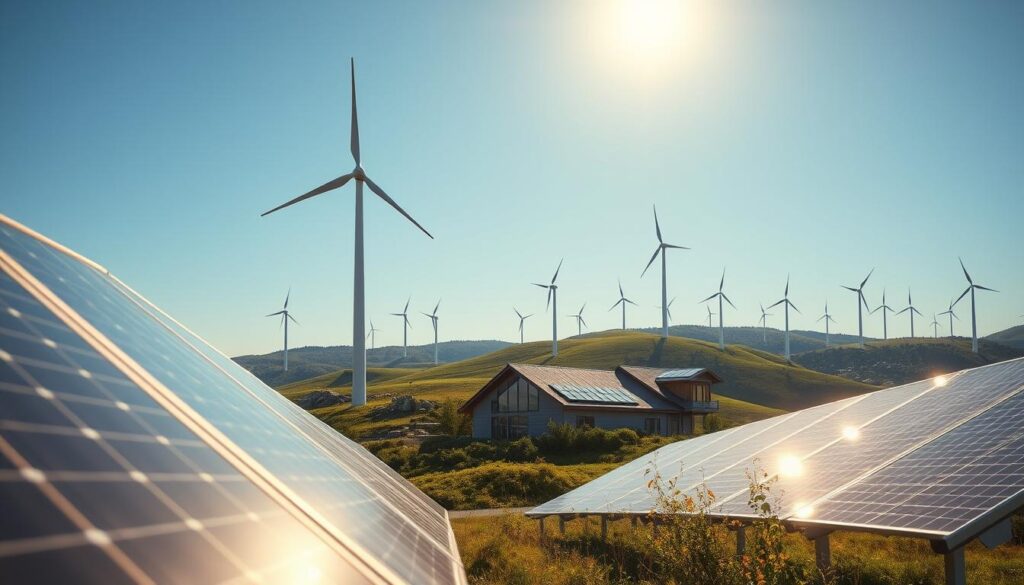As the world shifts towards sustainable living, the question arises: Can we rely on renewable energy systems to power our homes and communities?
The answer lies in understanding off-grid energy engineering, a field that has gained significant attention in recent years due to its potential to provide sustainable power solutions to those in need.
With the increasing demand for clean and efficient energy, off-grid solutions have become a vital component of modern energy systems.
Key Takeaways
- Understanding the basics of renewable energy systems.
- The importance of sustainable power solutions in today’s world.
- An overview of the components involved in off-grid energy engineering.
- The potential benefits of adopting off-grid energy solutions.
- Key considerations for implementing renewable energy systems.
Introduction to Off-Grid Energy Systems
The concept of off-grid energy engineering is gaining traction as a viable solution for those seeking energy independence and reduced carbon footprints. Off-grid energy systems are designed to operate independently of the traditional electrical grid, providing power through alternative energy technology.
What is Off-Grid Energy Engineering?
Off-grid energy engineering involves the design, installation, and maintenance of systems that generate power independently of the grid. This is achieved through the use of renewable energy sources such as solar, wind, and hydroelectric power. Independent power generation is the cornerstone of off-grid energy engineering, allowing individuals and communities to meet their energy needs sustainably.
Benefits of Off-Grid Energy Solutions
Off-grid energy solutions offer numerous benefits, including reduced reliance on fossil fuels, lower energy costs over time, and the ability to provide power in remote or off-grid locations. These systems can be customized to meet specific energy needs, making them highly versatile.
| Benefit | Description | Impact |
|---|---|---|
| Energy Independence | Ability to generate power without grid connection | High |
| Reduced Carbon Footprint | Utilization of renewable energy sources | Significant |
| Cost-Effectiveness | Lower energy costs over the system’s lifespan | Long-term |
By embracing off-grid energy solutions, individuals and organizations can contribute to a more sustainable future while enjoying the benefits of alternative energy technology. As the world continues to transition towards cleaner energy sources, the role of off-grid energy engineering is set to become increasingly important.
Understanding Energy Needs
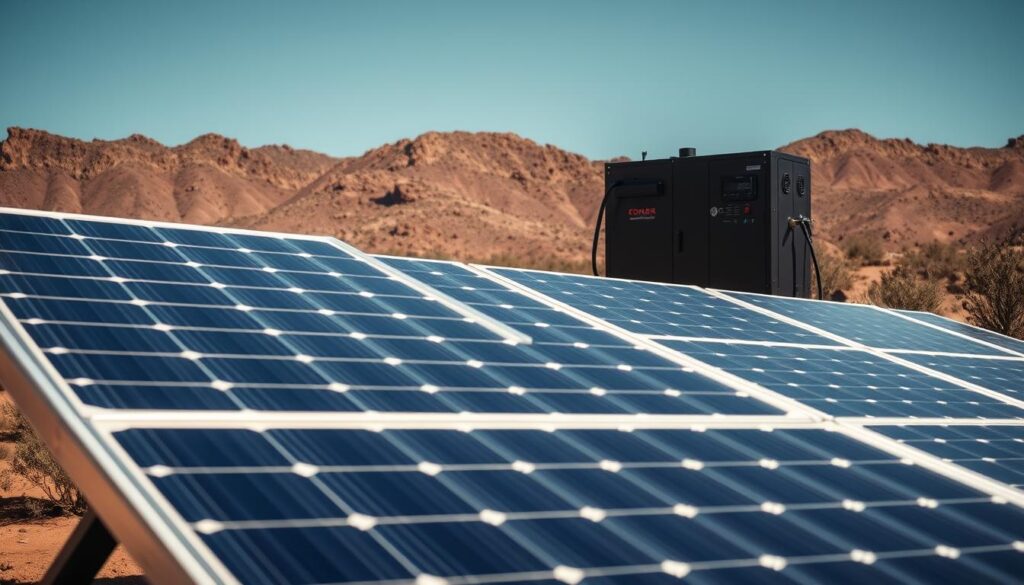
To design an efficient off-grid energy system, you must first understand your energy needs. This involves assessing your power requirements and calculating your energy consumption patterns.
Assessing Power Requirements for Your Space
Assessing your power requirements is a critical step in designing an effective off-grid solar system. It involves identifying all the appliances and devices that will be powered by the system.
- List all electrical appliances and devices.
- Determine the power rating of each appliance (usually found on the device or in the manual).
- Calculate the total energy required by summing up the power ratings.
For instance, if you’re planning to power lights, a refrigerator, and a computer, you’ll need to sum their power requirements to determine the total load.
Calculating Energy Consumption Patterns
Understanding your energy consumption patterns is vital for sizing your eco-friendly energy solution correctly. This involves analyzing how much energy you use over a specific period.
| Appliance | Power Rating (W) | Usage Hours/Day | Total Energy (Wh/Day) |
|---|---|---|---|
| LED Light | 9 | 8 | 72 |
| Refrigerator | 100 | 24 | 2400 |
| Computer | 65 | 4 | 260 |
| Total | 2732 |
As seen in the table, calculating the total energy consumption involves multiplying the power rating of each appliance by its usage hours and summing these values.
“The key to a successful off-grid energy system is accurately assessing your energy needs and designing your system accordingly.”
For more information on the differences between on-grid and off-grid solar systems, visit this resource to learn about the benefits and considerations of each.
Types of Off-Grid Energy Systems
As the demand for renewable energy grows, so does the variety of off-grid energy systems available. These systems cater to different needs and environments, providing a range of solutions for those looking to disconnect from the grid.
Solar Power Systems
Solar power systems are one of the most popular off-grid energy solutions. They harness energy from the sun using photovoltaic (PV) panels, converting it into electrical energy. The efficiency of solar panels has improved significantly over the years, making them a viable option for many.
The advantages of solar power systems include:
- Abundant resource availability
- Low operational costs
- Minimal environmental impact
Wind Energy Solutions
Wind energy solutions are another effective way to generate power off-grid. Wind turbines convert the kinetic energy from wind into electricity. The suitability of wind energy depends on the location’s wind speeds.
Key benefits of wind energy solutions include:
- High energy output in suitable locations
- Reduced reliance on fossil fuels
- Potential for cost savings
Hybrid Systems
Hybrid systems combine multiple energy sources, such as solar and wind, to provide a more reliable and efficient energy solution. These systems can mitigate the intermittency of single-source systems.
Advantages of hybrid systems include:
- Improved reliability
- Flexibility in energy generation
- Potential for reduced energy storage needs
| System Type | Primary Energy Source | Advantages |
|---|---|---|
| Solar Power | Sunlight | Abundant resource, low operational costs |
| Wind Energy | Wind | High energy output, reduced fossil fuel reliance |
| Hybrid | Multiple (e.g., solar and wind) | Improved reliability, flexibility |
Components of Off-Grid Energy Systems
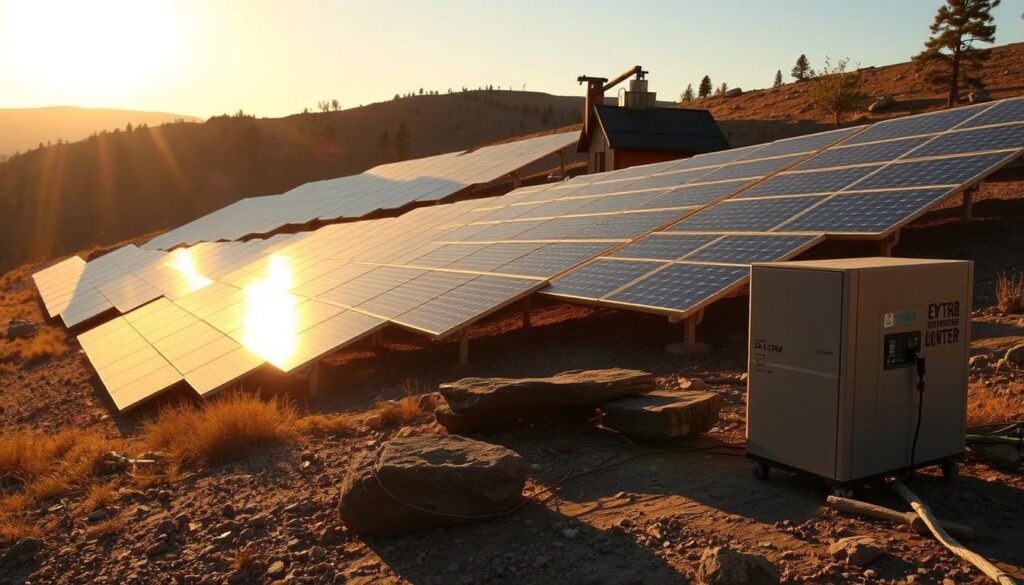
Understanding the components of off-grid energy systems is crucial for effective implementation. These systems are designed to operate independently of the grid, providing energy in remote or off-grid locations.
Solar Panels and Their Efficiency
Solar panels are a critical component of many off-grid energy systems, converting sunlight into electrical energy. The efficiency of solar panels is a key factor in determining the overall performance of the system.
Key factors affecting solar panel efficiency include:
- Panel quality and technology
- Angle and orientation of installation
- Environmental conditions such as temperature and shading
For instance, high-efficiency solar panels can achieve efficiencies of over 20%, significantly impacting the overall energy output.
Wind Turbines: Types and Uses
Wind turbines offer another viable option for off-grid energy generation, particularly in areas with consistent wind patterns. There are several types of wind turbines, each with its own advantages and applications.
| Type of Wind Turbine | Description | Typical Use |
|---|---|---|
| Horizontal Axis Wind Turbines | Most common type, with blades rotating around a horizontal axis | Residential and commercial installations |
| Vertical Axis Wind Turbines | Blades rotate around a vertical axis, suitable for urban areas | Urban and residential areas with space constraints |
Batteries and Energy Storage Options
Energy storage is a vital component of off-grid energy systems, allowing for the storage of excess energy generated during the day for use at night or during periods of low energy production.
Battery technologies have evolved significantly, offering various options for energy storage, including lead-acid, lithium-ion, and flow batteries.
Inverters: Converting DC to AC Power
Inverters play a crucial role in off-grid energy systems by converting the DC power generated by solar panels or wind turbines into AC power, which is usable in homes and businesses.
The choice of inverter depends on the system’s size, the type of energy source, and specific application requirements.
Planning Your Off-Grid Energy System
Effective planning is crucial for a successful off-grid energy system, requiring careful consideration of several key factors. A well-planned system ensures reliability, efficiency, and compliance with regulatory requirements.
Site Assessment and Location Considerations
A thorough site assessment is fundamental to designing an effective off-grid energy system. This involves evaluating the site’s solar irradiance, wind patterns, and other environmental factors to determine the most suitable energy sources. Off-grid energy consulting services can provide valuable insights and expertise in this area, helping to identify potential challenges and opportunities.
Location considerations also play a critical role in system design. For instance, areas with high winds may be more suitable for wind energy, while regions with abundant sunlight are ideal for solar power. Understanding these factors is essential for optimizing system performance.
Permitting and Regulatory Requirements
Compliance with local regulations and permitting requirements is a critical aspect of off-grid energy system planning. Off-grid electrical design must adhere to relevant building codes and standards, ensuring safety and efficiency. It’s essential to research and understand the specific regulations in your area to avoid potential issues during installation.
As noted by industry experts, “Understanding and complying with regulatory requirements is crucial for the successful implementation of off-grid energy systems.” This highlights the importance of working with experienced professionals who are familiar with local regulations and can guide you through the permitting process.
“The future of energy is off-grid, and it’s cleaner, smarter, and more efficient than traditional grid systems.”
By carefully planning your off-grid energy system, including thorough site assessment and compliance with regulatory requirements, you can ensure a sustainable power solution that meets your energy needs. This not only contributes to energy independence but also supports environmental sustainability.
Designing Your Off-Grid Energy Layout
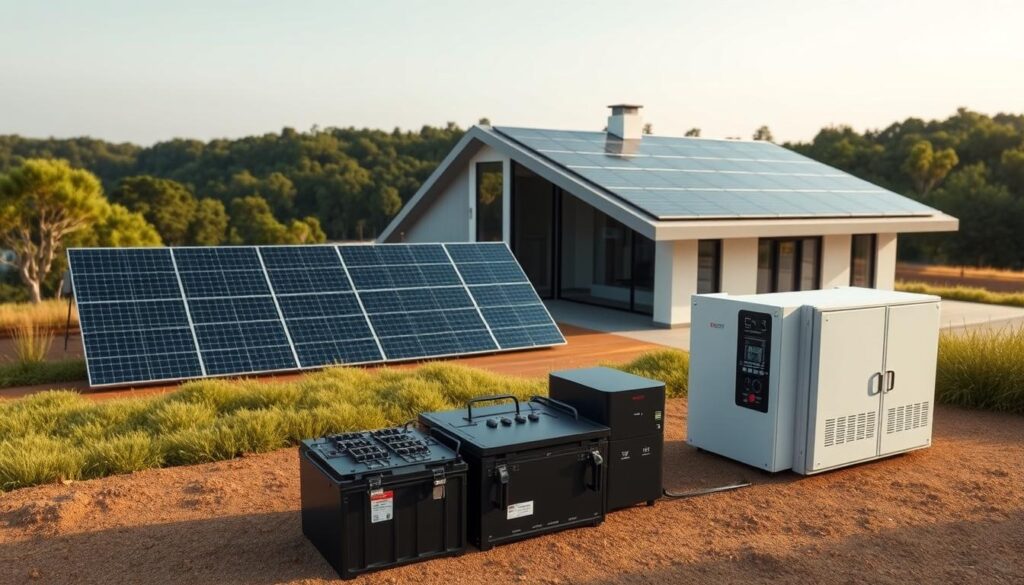
Off-grid energy systems demand precise design to ensure optimal performance and scalability. A well-designed system not only meets your current energy needs but also adapts to future demands.
System Sizing for Optimal Performance
System sizing is a critical aspect of off-grid energy design. It involves calculating your total energy requirements and determining the appropriate size of your energy generation and storage components. Proper system sizing ensures that your off-grid solar systems operate efficiently, providing reliable power without excessive cost or waste.
To size your system correctly, you must assess your daily energy consumption, considering factors like appliance efficiency, usage patterns, and potential future needs. This assessment will guide the selection of solar panels, wind turbines, or other energy sources, as well as the capacity of your energy storage solutions.
Creating a Scalable Energy Model
A scalable energy model allows your off-grid energy system to grow with your needs. This involves designing a system that can be easily expanded or modified as your energy requirements change. Scalability is particularly important for off-grid systems, as it enables you to start with a smaller, more affordable setup and gradually add more components as needed.
To create a scalable model, consider modular designs that allow for the addition of more solar panels, batteries, or other components. This approach not only makes your system more adaptable but also helps in managing initial costs and reducing the complexity of future upgrades.
By focusing on both system sizing and scalability, you can design an off-grid energy layout that is not only efficient and reliable but also sustainable and adaptable to your evolving energy needs.
Installation of Off-Grid Energy Systems
Effective installation of off-grid energy systems is crucial for maximizing their potential and ensuring a reliable energy supply. The process involves several critical decisions that impact the overall performance and safety of the system.
Hiring Professionals vs. DIY Installation
One of the primary decisions you’ll need to make during the installation process is whether to hire professionals or undertake the task yourself. Hiring professionals can offer several advantages, including expertise, efficiency, and warranty coverage. Professionals have the training and experience to handle complex installations, ensuring that the system is set up correctly and safely.
On the other hand, DIY installation can be a cost-effective option for those with the necessary skills and knowledge. It allows for greater control over the installation process and can be a valuable learning experience. However, it also comes with risks, such as potential safety hazards and the possibility of incorrect installation, which can lead to system inefficiencies or failures.
Best Practices for Installation
Regardless of whether you choose to hire professionals or go the DIY route, following best practices for installation is essential. This includes conducting thorough site assessments to determine the optimal placement for your system components, such as solar panels or wind turbines.
- Ensure that all components are compatible and meet the necessary standards for safety and efficiency.
- Follow manufacturer instructions and local building codes during the installation process.
- Implement proper grounding and bonding to protect against electrical surges and ensure system safety.
- Test the system thoroughly after installation to verify that it is operating as expected.
By adhering to these best practices and making informed decisions about your installation approach, you can ensure a successful off-grid energy system that provides reliable, sustainable power solutions for years to come.
Maintaining Your Off-Grid Energy System
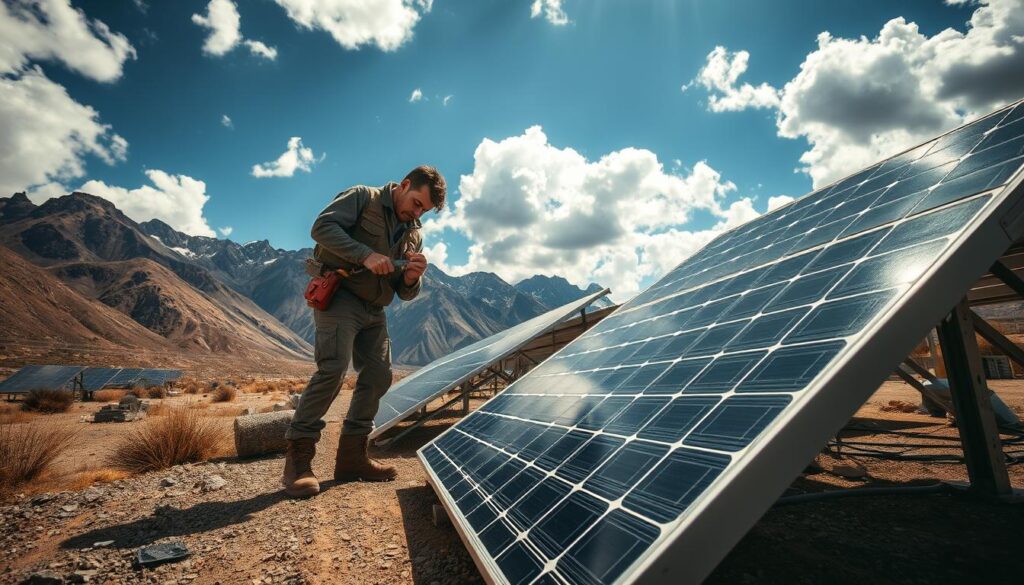
Maintaining your off-grid energy system is vital for maximizing its lifespan and efficiency. Regular maintenance not only ensures that your system operates at peak performance but also helps in identifying potential issues before they become major problems.
Routine Maintenance Tips
To keep your off-grid energy system running smoothly, follow these routine maintenance tips:
- Regularly inspect solar panels for dirt, debris, or damage that could affect their efficiency.
- Check battery health by monitoring voltage, state of charge, and ensuring proper maintenance as recommended by the manufacturer.
- Inspect wiring and connections for signs of wear, corrosion, or damage.
- Perform routine inverter maintenance as per the manufacturer’s instructions to ensure it’s functioning correctly.
- Keep the system clean and ensure that all components are free from dust and debris.
Troubleshooting Common Issues
Despite regular maintenance, issues can still arise. Here are some common problems and troubleshooting tips:
- Low Energy Output: Check for shading issues on solar panels, inspect for faulty panels, and ensure the inverter is functioning correctly.
- Battery Issues: Monitor battery voltage, check for proper connections, and ensure the charge controller is working as expected.
- System Not Starting: Verify that all connections are secure, check the inverter settings, and ensure there’s sufficient energy stored in the batteries.
By following these maintenance and troubleshooting tips, you can ensure your off-grid energy system remains efficient and reliable, providing you with sustainable power solutions for years to come.
Financial Considerations for Off-Grid Energy
Understanding the financial aspects of off-grid energy is crucial for making informed decisions about adopting sustainable power solutions.
Initial Costs and Budgeting
The initial investment for off-grid energy systems can be substantial, including costs for equipment such as solar panels or wind turbines, batteries, and inverters.
Budgeting for an off-grid energy system requires careful planning, considering not just the upfront costs but also ongoing maintenance and potential upgrades.
Long-Term Savings and ROI
While the initial costs can be high, off-grid energy systems offer significant long-term savings on energy bills.
Calculating the return on investment (ROI) involves considering these savings, as well as any incentives or tax credits available for renewable energy installations.
| System Component | Initial Cost | Long-Term Savings |
|---|---|---|
| Solar Panels | $10,000 | $500/year |
| Wind Turbine | $15,000 | $750/year |
| Battery Bank | $5,000 | $200/year |
By understanding both the initial costs and the potential long-term savings, individuals can make more informed decisions about transitioning to off-grid energy solutions.
Environmental Impact of Off-Grid Energy Engineering
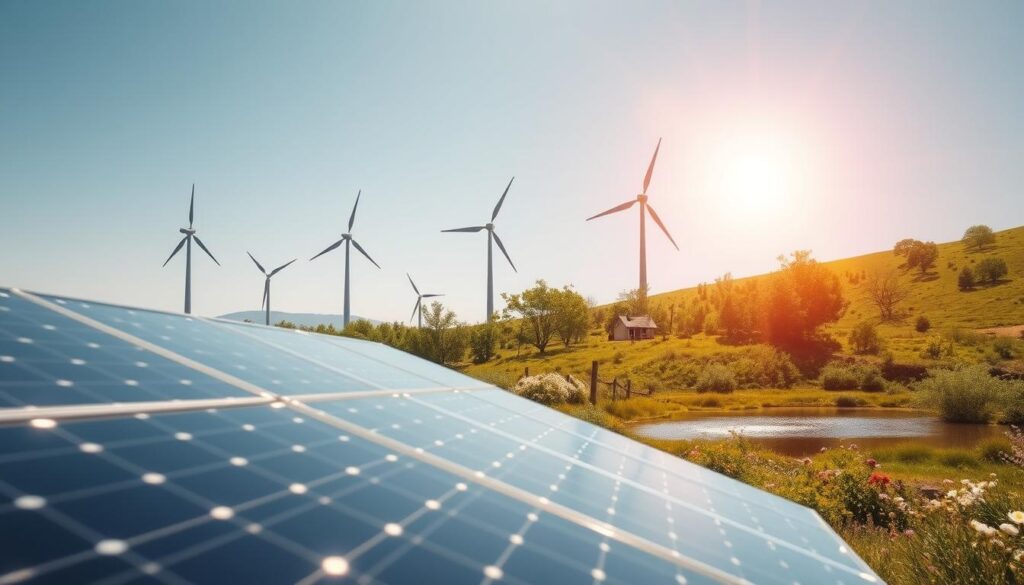
The shift towards off-grid energy solutions is a crucial step in mitigating climate change and promoting sustainable living. Off-grid energy engineering encompasses a range of technologies and practices that reduce our reliance on fossil fuels, thereby decreasing greenhouse gas emissions and supporting a cleaner environment.
Reducing Carbon Footprint
One of the most significant environmental benefits of off-grid energy engineering is the reduction in carbon footprint. By harnessing renewable energy sources such as solar and wind power, we can significantly decrease our dependence on fossil fuels, which are major contributors to CO2 emissions. According to a study published on Nature, transitioning to renewable energy can lead to substantial reductions in greenhouse gas emissions.
- Decreased reliance on fossil fuels
- Lower emissions of CO2 and other greenhouse gases
- Promotion of sustainable energy practices
Sustainability Considerations
Off-grid energy systems not only reduce carbon footprint but also promote sustainability through the use of sustainable power solutions. These systems can be designed to be highly efficient, minimizing energy waste and optimizing energy production. Furthermore, the use of renewable energy systems ensures that energy production is sustainable over the long term. For more information on sustainable practices, visit World Civil Society.
- Designing efficient energy systems
- Utilizing renewable energy sources
- Promoting energy independence
In conclusion, off-grid energy engineering plays a vital role in reducing our environmental impact by decreasing carbon footprint and promoting sustainability. As we continue to develop and implement eco-friendly energy solutions, we move closer to a more sustainable future.
Case Studies of Successful Off-Grid Systems
Successful off-grid energy installations are a testament to the viability of renewable energy sources. These systems have been implemented in various settings, from residential homes to commercial establishments, showcasing the flexibility and potential of off-grid energy solutions.
Residential Off-Grid Installations
Residential off-grid installations have empowered homeowners to take control of their energy needs. For instance, a family in a remote area installed an off-grid solar system, which now powers their entire home. This not only reduced their reliance on fossil fuels but also lowered their energy bills significantly.
A case study on a residential off-grid installation in California revealed that the homeowners were able to save up to 70% on their energy costs within the first year. The system consisted of solar panels, a battery bank for energy storage, and an inverter to convert DC power to AC.
Commercial Off-Grid Solutions
Commercial off-grid solutions are also gaining traction, with businesses recognizing the benefits of sustainable power. A notable example is a commercial building in New York that implemented an off-grid energy system to reduce its carbon footprint. The system includes wind turbines and solar panels, providing a hybrid solution that ensures a consistent energy supply.
For more information on renewable energy in off-grid systems, visit Discover Engineering.
| Installation Type | Energy Source | Cost Savings |
|---|---|---|
| Residential | Solar | 70% |
| Commercial | Hybrid (Solar + Wind) | 60% |
These case studies demonstrate the effectiveness of sustainable power solutions in both residential and commercial settings. By adopting off-grid energy systems, individuals and businesses can reduce their environmental impact while enjoying significant cost savings.
Future Trends in Off-Grid Energy Technology
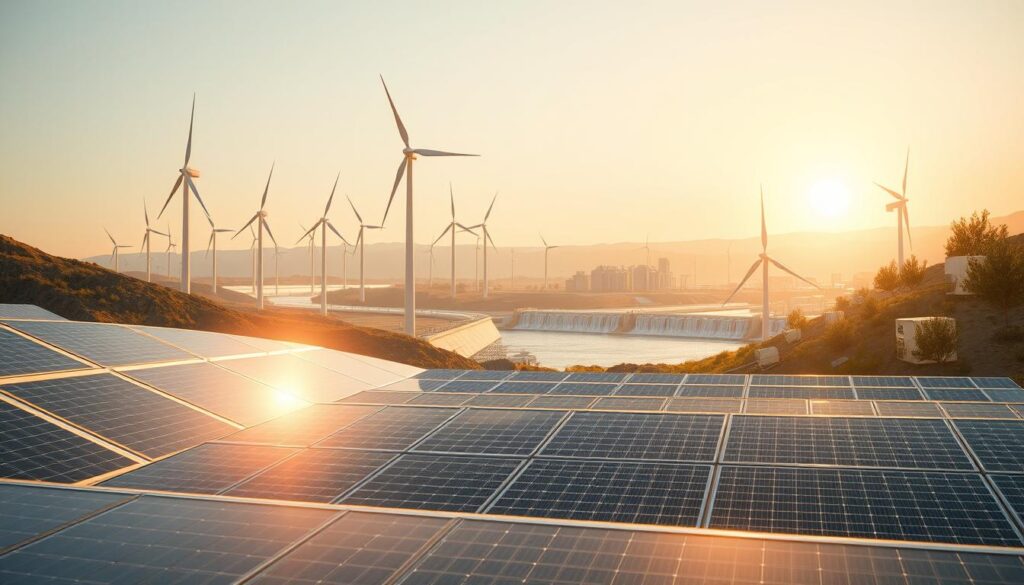
The off-grid energy sector is on the cusp of a revolution, driven by advancements in sustainable power solutions. As the world continues to shift towards renewable energy systems, the need for innovative and efficient off-grid energy technology is becoming increasingly important.
One of the key areas driving this revolution is advances in energy storage. New battery technologies and energy storage systems are being developed to improve efficiency, reduce costs, and enhance the overall performance of off-grid energy systems.
Advances in Energy Storage
Energy storage is a critical component of off-grid energy systems, allowing for the storage of excess energy generated during the day for use at night or during periods of low energy production. Recent advancements in battery technology have led to more efficient and cost-effective energy storage solutions.
| Technology | Description | Benefits |
|---|---|---|
| Lithium-Ion Batteries | High-energy density batteries with long cycle life | High efficiency, long lifespan |
| Lead-Acid Batteries | Cost-effective batteries with established manufacturing infrastructure | Low upfront cost, well-established supply chain |
| Flow Batteries | Batteries that store energy in liquid electrolytes in external tanks | Scalable, long-duration energy storage |
For more information on the evolving technology in off-grid living, visit Deltech Homes to explore the latest developments.
Innovations in Renewable Energy Sources
In addition to advances in energy storage, there are significant innovations in renewable energy sources. Solar and wind energy technologies are becoming more efficient and affordable, making off-grid energy systems more viable for a wider range of applications.
The integration of these technologies is set to transform the off-grid energy landscape, providing more sustainable power solutions for homes and businesses. As alternative energy technology continues to evolve, we can expect to see even more innovative solutions emerge, further enhancing the efficiency and reliability of off-grid energy systems.
Resources and Tools for Off-Grid Energy Engineering
Off-grid energy engineering requires a comprehensive approach, and leveraging the right resources and tools is crucial for success. As we delve into the specifics of off-grid energy systems, it becomes evident that having access to the right software and support networks can significantly enhance the design and implementation process.
Recommended Software for System Design
Utilizing the right software is vital for designing efficient off-grid energy systems. There are several tools available that can help in assessing energy needs, designing system layouts, and predicting performance. For instance, free design tools for solar energy can be incredibly useful for professionals and DIY enthusiasts alike.
Some of the key features to look for in off-grid energy design software include the ability to model different energy sources, simulate various environmental conditions, and optimize system configurations. By leveraging these tools, individuals can create more efficient and cost-effective off-grid energy solutions.
Online Communities and Support Networks
Beyond software tools, connecting with online communities and support networks can provide invaluable insights and assistance. These platforms allow individuals to share experiences, ask questions, and learn from others who are working on similar off-grid energy projects.
Engaging with these communities not only fosters a sense of collaboration but also helps in staying updated with the latest trends and technologies in off-grid energy consulting and sustainable power solutions. Whether you’re looking for advice on off-grid electrical design or seeking to share your own knowledge, these networks are a powerful resource.
By combining the right software tools with active participation in online communities, individuals can significantly enhance their off-grid energy engineering projects, leading to more sustainable and efficient energy solutions.
Conclusion: Embracing Off-Grid Living
Off-grid energy engineering is revolutionizing the way we think about power generation and consumption. By harnessing sustainable power solutions, individuals can reduce their reliance on traditional energy sources and promote eco-friendly energy solutions.
Energy Independence on the Horizon
The future of energy independence is bright, with advancements in off-grid energy engineering paving the way for a more sustainable tomorrow. As technology continues to evolve, we can expect to see even more innovative solutions emerge, making it easier for individuals to adopt off-grid living.
Fostering Sustainable Practices
By embracing off-grid energy engineering, we can foster sustainable practices that benefit both the environment and our communities. As we move forward, it’s essential to continue promoting eco-friendly energy solutions that support a healthier planet.
